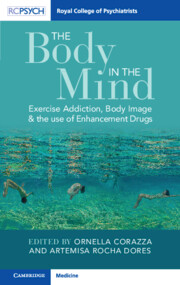Book contents
- The Body in the Mind
- The Body in the Mind
- Copyright page
- Dedication
- Contents
- Figures
- Tables
- Boxes
- Contributors
- Acknowledgements
- Introduction
- Section 1 From Exercise to Addiction: An Introduction to the Phenomenon
- Chapter 1 Exercise Addiction
- Chapter 2 From Exercise to Addiction
- Chapter 3 The COVID-19 Pandemic
- Chapter 4 Excessive Exercise and Image- and Performance-Enhancing Drug Use Among Sports Disciplines, and the Role of Mind–Body Training
- Chapter 5 The Ideal of the Perfect Body
- Chapter 6 Exercise, Fitspiration, and the Role of Social Media
- Chapter 7 Eating Disorders and Over-Exercise
- Chapter 8 Exercise and the Use of Image- and Performance-Enhancing Drugs within the Gym Environment
- Chapter 9 Bodybuilding, Exercise, and Image- and Performance-Enhancing Drug Use during the COVID-19 Pandemic
- Chapter 10 How to Treat Exercise Addiction
- Section 2 Reaching the Extreme with Exercise: A Collection of Clinical Case Studies
- Section 3 Exploring the Motivations Behind Exercise Addiction
- Index
- References
Chapter 10 - How to Treat Exercise Addiction
Psychological Interventions and New Pharmacological Perspectives
from Section 1 - From Exercise to Addiction: An Introduction to the Phenomenon
Published online by Cambridge University Press: 30 March 2023
- The Body in the Mind
- The Body in the Mind
- Copyright page
- Dedication
- Contents
- Figures
- Tables
- Boxes
- Contributors
- Acknowledgements
- Introduction
- Section 1 From Exercise to Addiction: An Introduction to the Phenomenon
- Chapter 1 Exercise Addiction
- Chapter 2 From Exercise to Addiction
- Chapter 3 The COVID-19 Pandemic
- Chapter 4 Excessive Exercise and Image- and Performance-Enhancing Drug Use Among Sports Disciplines, and the Role of Mind–Body Training
- Chapter 5 The Ideal of the Perfect Body
- Chapter 6 Exercise, Fitspiration, and the Role of Social Media
- Chapter 7 Eating Disorders and Over-Exercise
- Chapter 8 Exercise and the Use of Image- and Performance-Enhancing Drugs within the Gym Environment
- Chapter 9 Bodybuilding, Exercise, and Image- and Performance-Enhancing Drug Use during the COVID-19 Pandemic
- Chapter 10 How to Treat Exercise Addiction
- Section 2 Reaching the Extreme with Exercise: A Collection of Clinical Case Studies
- Section 3 Exploring the Motivations Behind Exercise Addiction
- Index
- References
Summary
Exercise addiction (EA) is probably the most ‘hidden’ of the behavioural addictions. In a society in which a fit body is normally considered to be a symptom of a healthy lifestyle and success, the assessment and treatment of a maladaptive and health-threatening pattern of exercise may be challenging for healthcare professionals. Furthermore, the lack of guidance and literature on the topic may represent an additional complication on the diagnostic and therapeutic pathway. Although EA is not included in the DSM-5, it is mandatory to inform clinicians about it, as well as other healthcare providers (e.g., psychotherapists, physiotherapists), in order to better identify early signs of such an addiction and prevent injuries or other serious effects on physical or mental health. This chapter provides information on the aetiological basis of EA as well as a compendium of psychological and pharmacological interventions.
- Type
- Chapter
- Information
- The Body in the MindExercise Addiction, Body Image and the Use of Enhancement Drugs, pp. 145 - 162Publisher: Cambridge University PressPrint publication year: 2023



